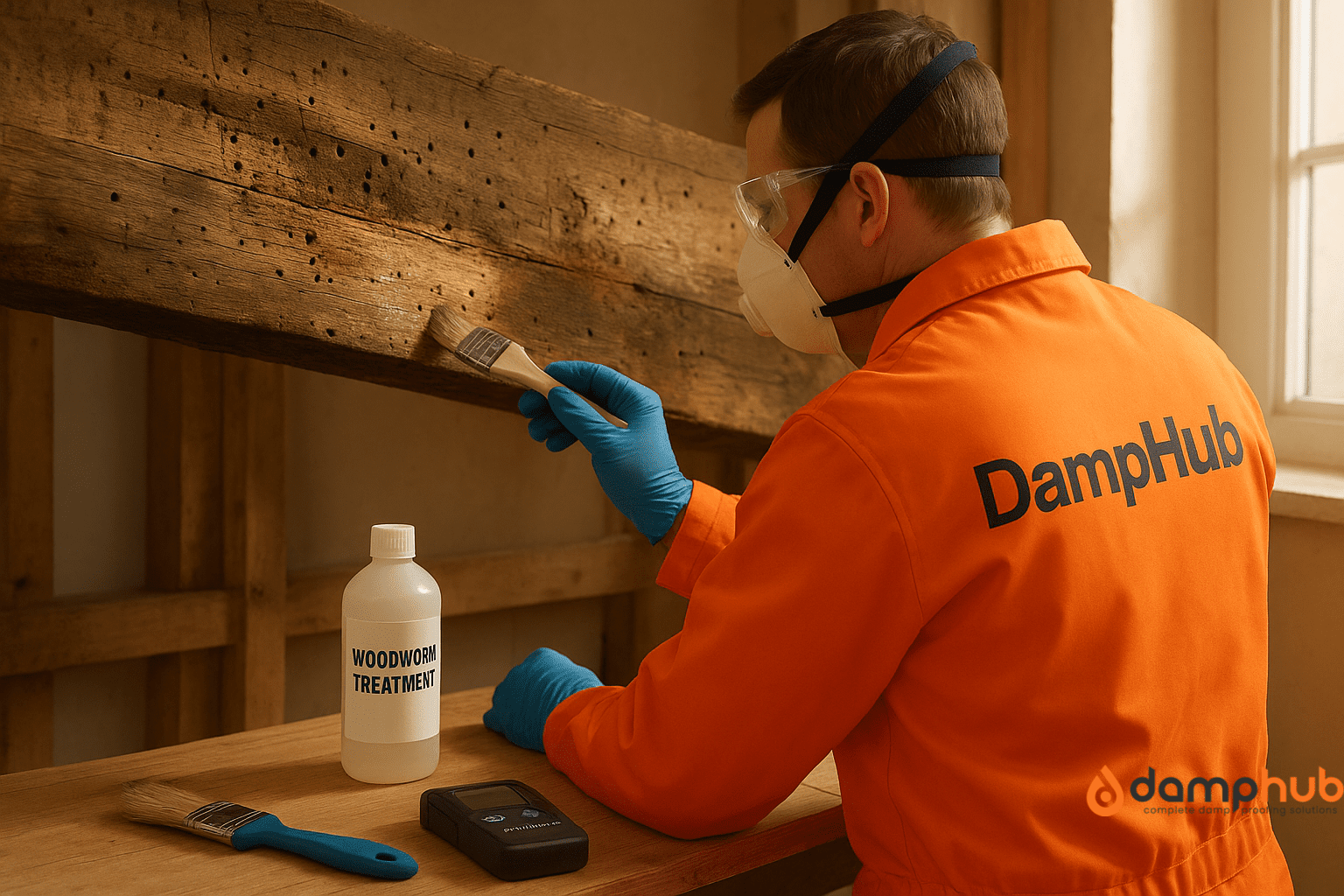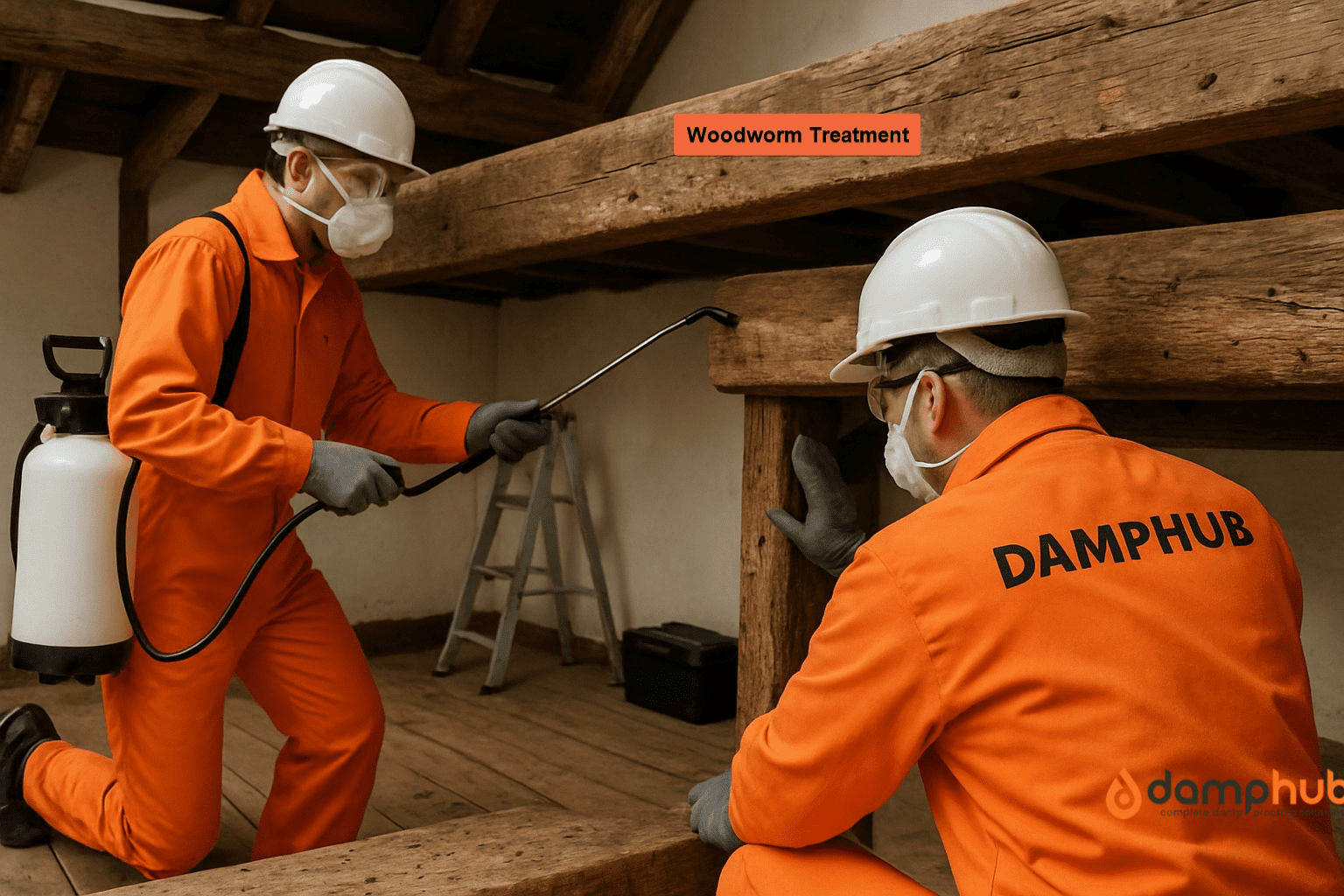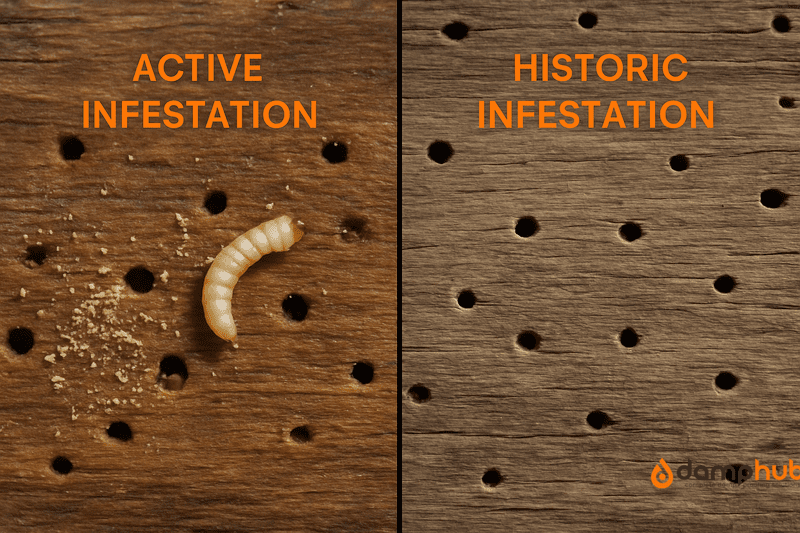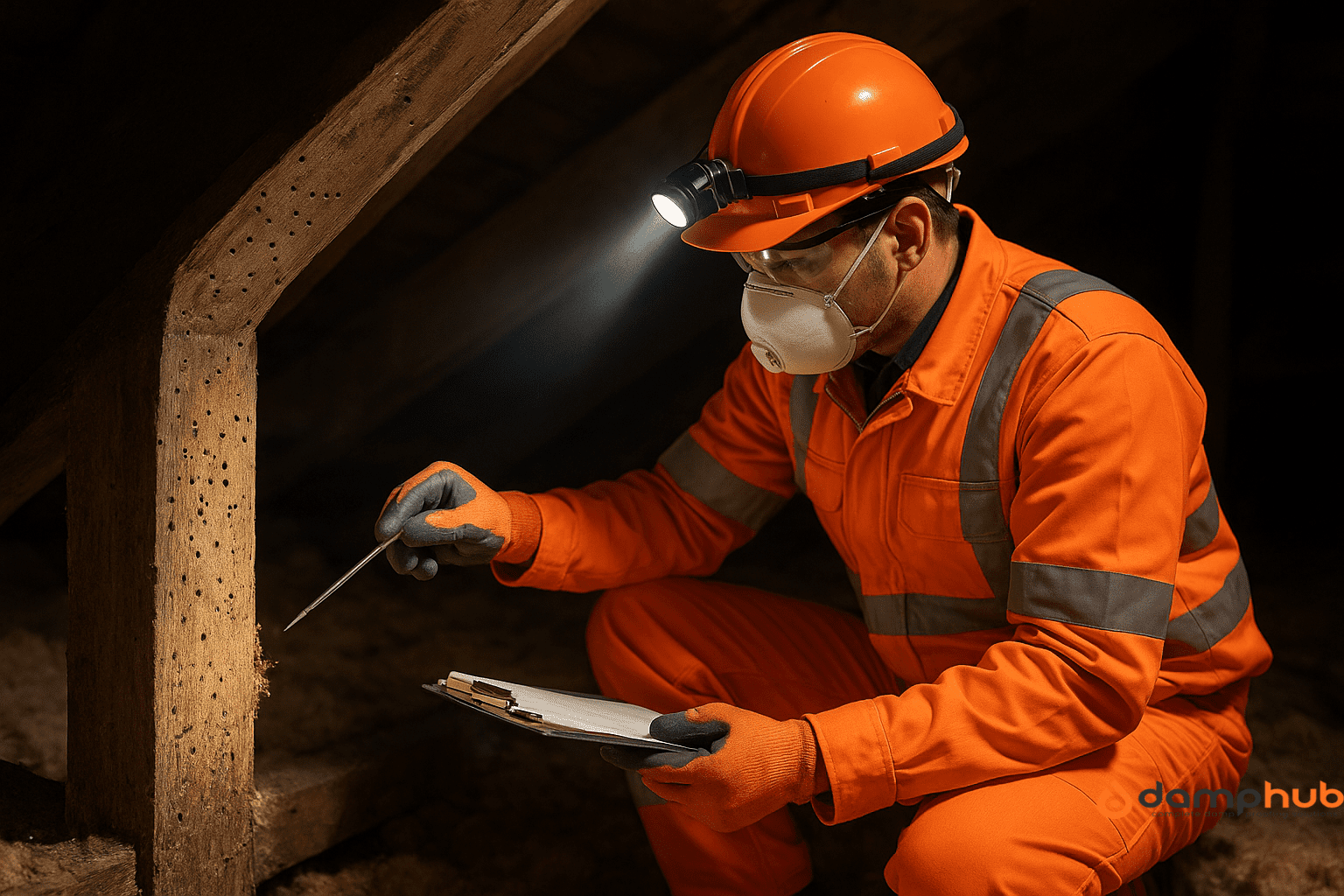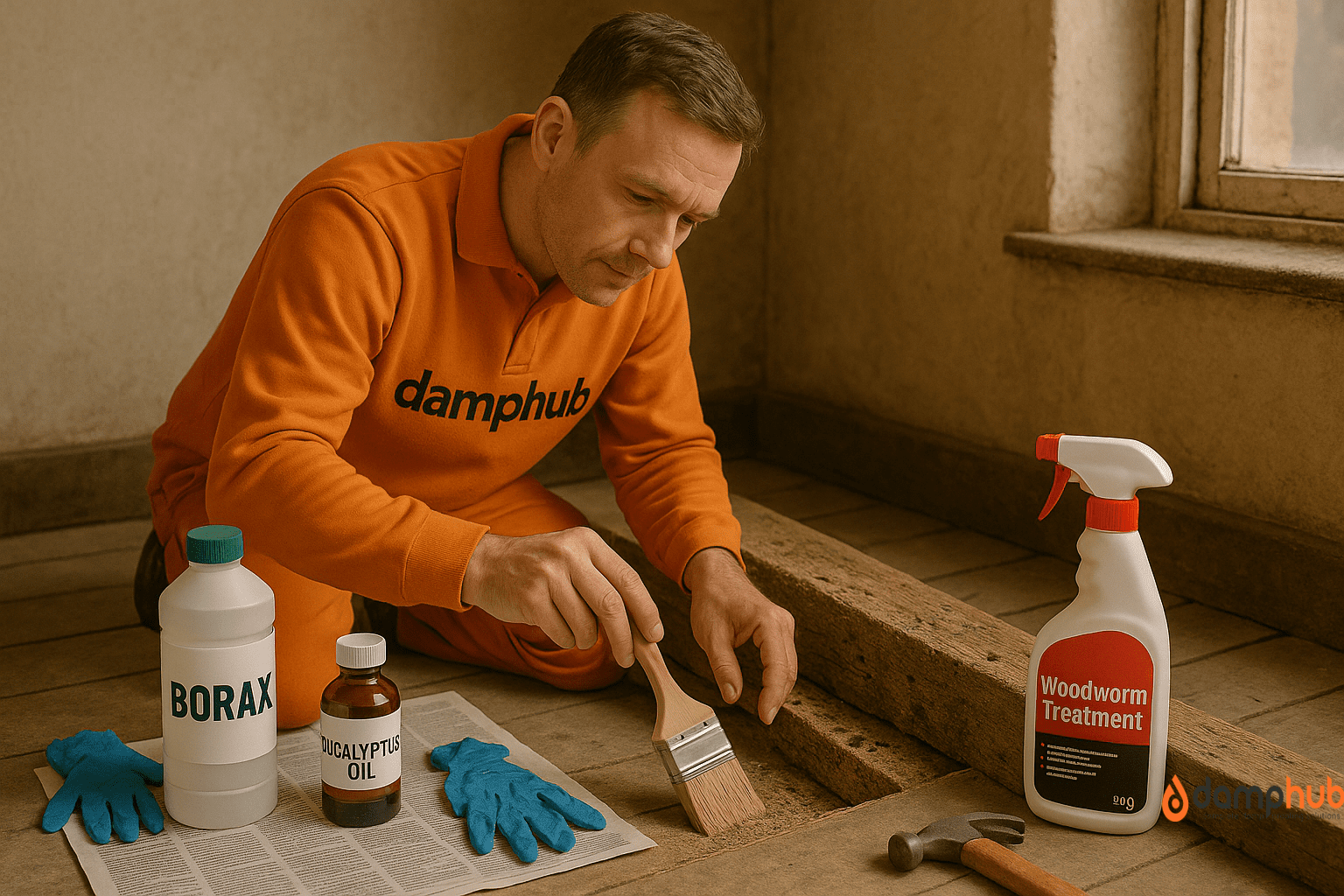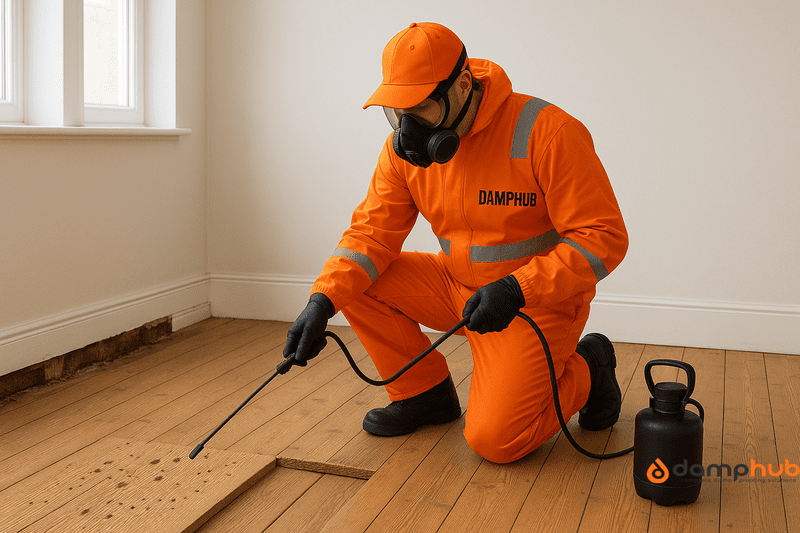
Picture this. You’re walking across your lounge, cup of tea in hand, when one floorboard makes an odd sound. Not the usual creak. More… hollow. You kneel, spot a tiny round hole, and wonder if the cat’s been at it. Then you see another hole. And a sprinkle of pale dust.
That’s the moment you start thinking, “Woodworm. Oh no.”
Don’t worry — you’re not the first, and you won’t be the last. But the sooner you understand what’s going on under your feet, the better your chances of stopping it before it turns your lovely floor into a patchwork of wobbly boards.
What is Woodworm in Floorboards?
Woodworm in floorboards means beetle larvae live and feed inside the wood under your feet. These tiny bugs tunnel through the timber for years, leaving small holes on the surface. It’s not a real worm—the name stuck because of the damage they cause.
In the UK, common furniture beetles and deathwatch beetles are the main troublemakers in your floorboards. They invade it because the wood is often soft and can hold a bit of moisture, which offers the perfect environment for the larvae to survive and grow.
So, when you hear “woodworm in floorboards,” it means these little larvae are quietly eating away at your floors from the inside.
How to Tell if You Have Woodworm in Floorboards
Look for small round holes about 1 to 2 millimetres wide. These are where beetles have left the wood. Fresh holes often have pale frass around them. This is a fine powder made of wood and droppings. If you clean the area and the powder returns, the woodworms are still active.
Other hints:
- Edges of boards starting to crumble.
- A hollow sound when you tap the wood.
- Weakness when you press down.
For more guidance on how to spot woodworm in your property, make sure to read our guide: Signs of Active Woodworm Infestation
Pro Tip
A simple check is to mark a few suspect holes with a bit of masking tape and see if new ones appear over the next few months.
Can Woodworm Damage Floorboards?
Absolutely. One or two beetles won’t collapse your sitting room floor overnight, but given time, an active infestation can weaken boards enough for them to split or even break when walked on.
In older homes where the joists are also affected, you can end up with real safety concerns. We’ve been in properties where the floorboards looked fine on top but had the consistency of Weetabix underneath.
If your boards are decorative — original pine with character — damage is even more frustrating. Once it’s gone, you can’t truly replace that aged look.
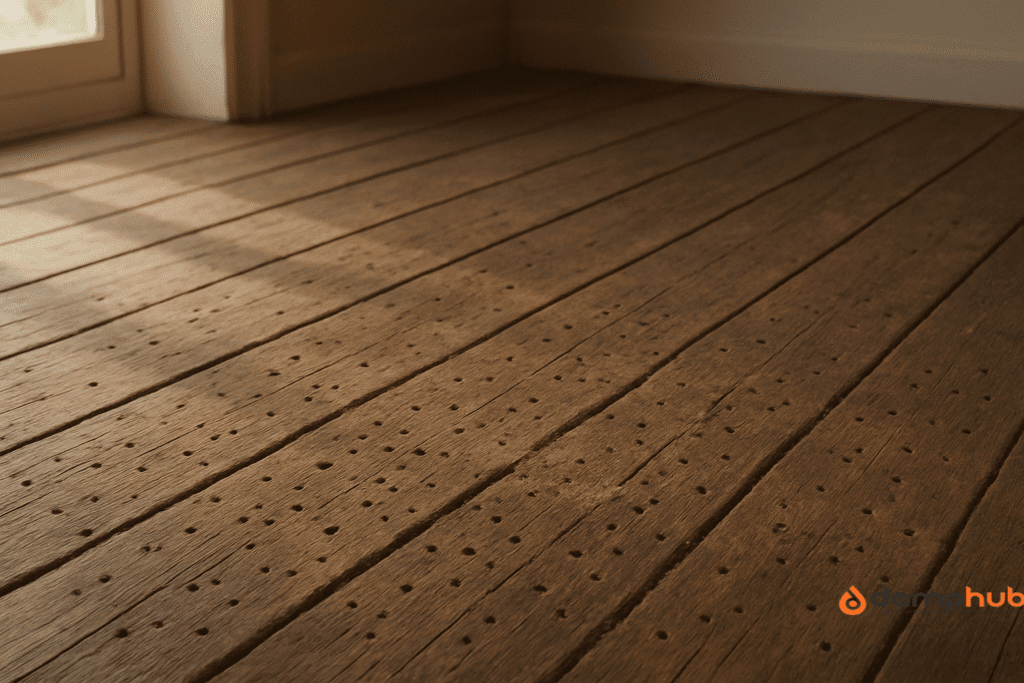
How to Treat Woodworm in Floorboards Yourself
If you catch it early and it’s only in a few spots, you can go the DIY woodworm treatment way. Here’s how:
- Clear the area — Lift carpets or rugs. Hoover away any dust so you can see what you’re dealing with.
- Choose your treatment — Most DIY options come as liquid or gel. Liquid soaks in and kills larvae inside. Gel is good for deep penetration into thicker boards.
- Apply generously — Brush or spray, following the product instructions. Make sure you get into cracks and edges.
- Ventilate — These treatments can be strong-smelling. Keep windows open.
- Repeat if needed — Some products need a second coat after a set period.
Pro Tip
Treat at least a metre around the visibly affected area. The larvae can be hiding where you can’t see them yet.
What’s the Best Woodworm Treatment for Floorboards?
There isn’t a single “best” for everyone. It depends on how bad things are.
- Water-based insecticides are popular for DIY because they’re easier to use and less smelly than solvent-based ones.
- Boron-based gels are good for thicker boards, especially if they’ve got dampness.
- Professional fumigation or deep injection treatments are best for severe or widespread cases.
If you want peace of mind and the job done quickly, a pro will have access to stronger products than you can buy over the counter.
How Long Do You Need To Treat Woodworm in Floorboards?
For a DIY job, applying the treatment itself might only take an afternoon. But the real “time” is in how long it takes to stop the life cycle.
The larvae can live inside for years, so even after you’ve treated, you may see the odd beetle emerging the following spring. That doesn’t always mean failure — sometimes it’s just the last few maturing after you’ve poisoned the wood.
Professionals can speed things up with more potent chemicals, but even then, you’re looking at a process that runs over months in the background.
Related post: How to Treat Woodworm in Furniture
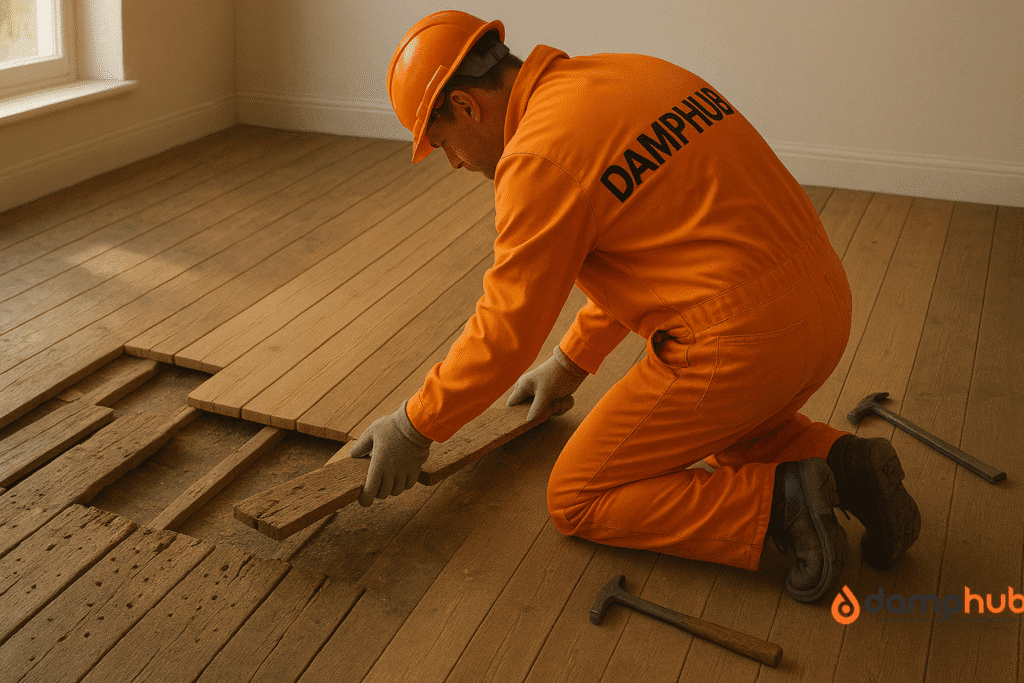
When Should I Call a Professional for Woodworm?
- If more than one room’s flooring shows signs.
- If joists or structural beams are affected.
- If the boards are already breaking under weight.
- If you’ve treated before and it’s still active.
Also, if you’re planning to sell your home, a professional report can be worth its weight in gold to calm buyers’ nerves.
How to Prevent Woodworm in Floorboards
Think of woodworm as a pest that thrives in damp, quiet, undisturbed wood.
- Keep your home well-ventilated to reduce moisture.
- Fix leaks quickly — even a small drip under floorboards can be an invitation.
- Lift rugs occasionally so boards can “breathe.”
- Store firewood outside, not on the floor indoors.
Once a year, give your floors a proper inspection. It’s like going to the dentist — catch problems early, save yourself a lot of grief.
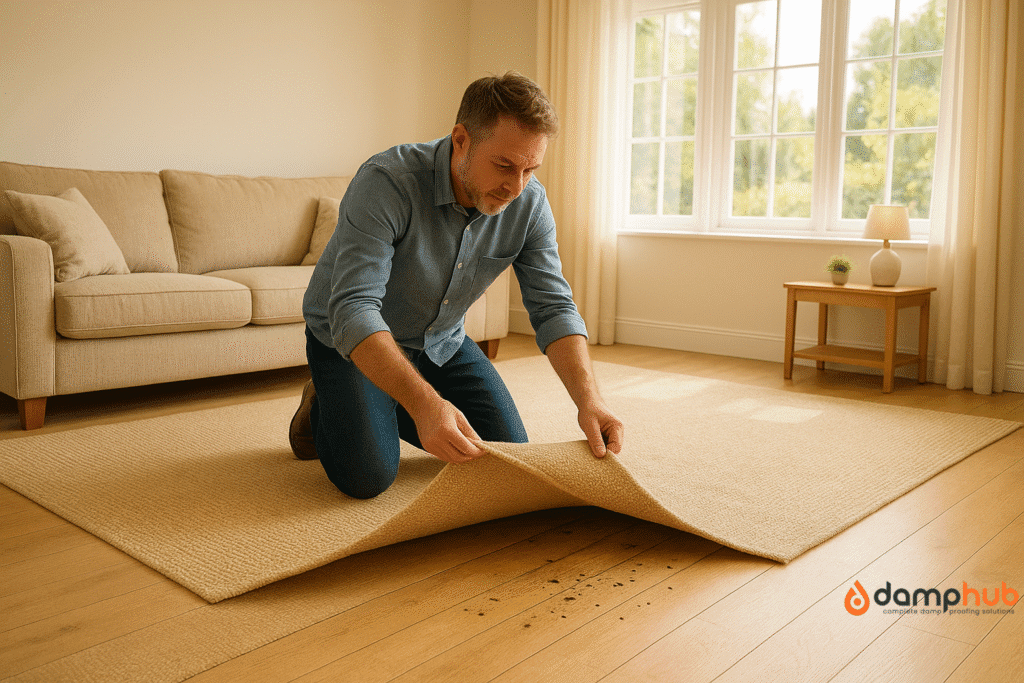
What Happens if Woodworm in Floorboards is Left Untreated?
The short answer: it gets worse. The longer answer: larvae keep feeding, holes multiply, the strength of the boards drops, and eventually you’re replacing whole sections of flooring — or worse, dealing with joist repairs.
Left long enough, the woodworm treatment cost can reach several thousand dollars. And it’s one of those repairs you can’t put off without risking safety.
How Often Should I Check My Floorboards for Woodworm?
Getting a surveyor to check your floorboards once a year usually does the trick. Think of it like a quick health check for your floors.
But if your home is a bit older or if you’ve had woodworm drama before, it’s smart to peek twice a year — spring and autumn make sense because the weather’s changing, and that can wake the bugs up.
Don’t just glance down. Get hands-on. Run your fingers over the boards, shine a flashlight sideways to catch tiny holes or dust you might miss, and listen for any new creaks or soft spots. These little clues can save you from a bigger mess later on.
If you or surveyor finds woodworm during the survey, read our guide on What to Do when a Woodworm Survey Reveals Woodworm to know the best course of action
Can Woodworm Spread from Floorboards to Furniture?
Most of the time, once a year is enough to keep an eye on your floorboards. It’s like giving them a quick once-over to make sure no tiny beetle parties are happening under your feet.
But, if your house is on the older side or you’ve battled woodworm before, you might want to peek twice a year. Spring and autumn are prime times because that’s when woodworm love to stir. Changing weather wakes them up — a bit like us needing coffee in the morning.
Don’t just stare down at the floor. Get hands-on. Run your fingers over the wood, shine a flashlight sideways to catch those sneaky little holes or dusty spots you might miss otherwise. Listen too; any new creaks or soft patches could be your floor sending a warning.
How to Fill Woodworm Holes in Floorboards
So, you’ve spotted those tiny woodworm holes and want to fix them up?
- Why fill the woodworm holes?
- Keeps moisture out — woodworm thrives in damp wood.
- Stops damage from spreading deeper inside.
- Makes your floor nicer to walk on — no more snagging socks!
- Quick test before you start:
Gently poke the wood with a screwdriver or similar tool. If it feels spongy or breaks easily, filler won’t cut it. Time to think about replacing.
How to fill woodworm holes:
- Check the wood’s condition first: Run your fingers over the floorboard. If it feels solid and firm, you’re good to go with filler. If it’s soft or crumbly, filler won’t help much.
- Pick a wood filler that matches your floor: The closer the colour, the less noticeable the repair. Nobody wants spots all over their floor!
- Apply the filler carefully: Use a small spatula or putty knife to press the filler right into each hole. Don’t just dab it on — pack it in firmly so the hole is fully sealed.
- Let it dry and then sand it smooth: Give the filler plenty of time to harden before sanding. This helps the patch blend seamlessly with the rest of the floor.
- For big clusters or damaged areas, consider replacement: If the wood feels weak or there are lots of holes in one spot, it’s best to swap out that section of floorboard. Filler won’t restore strength here.
Can I Use Household Bug Spray to Kill Woodworm?
Most household bug sprays won’t work on woodworm because the larvae live deep inside the timber. Surface treatments can’t reach them, so the infestation carries on.
You need a product designed for woodworm or wood-boring beetles, often containing boron, which soaks into the wood to kill larvae where they are.
Final Thoughts
Finding woodworm in your floorboards is annoying, but it’s not a reason to panic. Tackle it early, choose the right treatment, and you can save your floors without breaking the bank. Leave it, and you might be in for a much bigger job.
Always remember — the beetles might be tiny, but they’ve got big appetites. Don’t give them a long lunch break.
Woodworm In Floorboards: Questions Answered

-
Does Woodworm in Floorboard Cause Health Problems?
The beetles themselves aren’t going to bite you. The dust from damaged wood, though, can be irritating to the lungs, especially if you already have asthma or allergies. And some treatments have strong chemicals, so always ventilate and wear a mask when applying
-
How to test for woodworm in floorboards?
First off, peek at your floor. See any tiny round holes, about the size of a pinhead? That’s a clue. Next, look for some pale dust nearby — that’s beetle poop, probably. Tap the wood too. If it sounds hollow or feels a bit soft, you’ve got woodworm living in there. A screwdriver poke can confirm if the wood’s gone crumbly.
-
Are holes in floorboards always woodworm?
Nope. Sometimes nails, or natural knots in the wood, make holes. But if the holes are neat, round, and you spot that powdery dust around them? That’s woodworm’s calling card. If you see a bunch close together, better check it out before it gets worse.
-
Can I ignore woodworm?
You shouldn’t. These little critters munch away silently, turning solid wood into Swiss cheese over time. Ignoring it is like leaving your car without oil — eventually, things break down, and it’s gonna cost you a ton to fix.
-
How do you know if woodworm is dormant?
If the holes look old and there’s no fresh dust, the woodworm might be on a break. But don’t get too comfy. If the wood gets damp or cold, those bugs could wake up and start chewing again. So keep an eye on it.
-
How to know if woodworm has spread?
Watch out for new holes popping up nearby — on floorboards, skirting boards, or wooden furniture. Dust piles appearing out of nowhere are a dead giveaway. The more holes, the bigger the mess. Time to act before it’s a full-blown infestation.
-
Where do woodworms lay their eggs?
They’re sneaky. Beetles find cracks or rough spots in wood to drop their tiny eggs. These hatch into larvae that burrow inside and start their feast. You won’t spot the eggs with your naked eye — they’re super small and well hidden.
-
What do woodworms look like to the human eye?
The grown-ups? Tiny, about the size of a grain of rice, usually brown or reddish. The beetle babies live inside the wood, creamy-white and wormy, so you don’t see them. The real clue is those neat exit holes and that dusty mess they leave behind.

